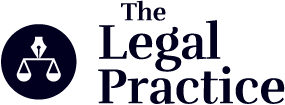Law firm marketing has evolved from handshakes and TV ads to tech-savvy digital strategies. Today's lawyers must connect online to generate leads and build trust with ideal clients.
In a competitive landscape, law firm marketing keeps firms visible and relevant. It’s a strategic approach to building reputation and connections with the right clients through clarifying messages and fostering trust.
Establish a marketing budget to effectively target growth channels. A starting investment helps prioritize strategies and refine marketing systems, evolving into a profitable skill over time.
Create a professional, user-friendly website as a first impression for potential clients. Include essential elements like testimonials and contact forms to ensure a clear and inviting experience.
Boost authority through valuable content like blog posts and videos. Offering helpful insights triggers search traffic, converting interest into leads and establishing you as an expert in your niche.
Law firm marketing used to be all handshakes and word-of-mouth. Maybe a pointed, low-fi TV ad that will be stylistically parodied on every prime time comedy show ad nauseam. But no more. Now, law firm practice managers and independent lawyers need to be tech- and digital marketing-savvy to get their website (and services) seen online.
In this guide, I’ll show you exactly how to build a powerful, modern marketing plan that helps you generate more leads, establish your expertise, and become the go-to trusted firm for your ideal clients.
What is Law Firm Marketing?
Law firm marketing is the process of promoting your legal services to attract new clients.
It’s not just about posting a few social media updates or handing out business cards at a networking event; it’s a strategic approach to building your reputation, making yourself known to your ideal clients, and staying top of mind with the people you want to serve most.
Think of it as your law firm’s handshake with the world (only less awkward and far more effective).
Why Is Law Firm Marketing Important?
Law firm marketing is important because it’s how your firm stays visible, relevant, and competitive in a crowded legal landscape.
If people don’t know you exist or can’t tell why you’re different, they’ll choose someone else.
Here’s why understanding law firm marketing matters:
- It connects you with the right audience: Marketing helps you reach people who actually need your services, instead of waiting for referrals to trickle in.
- It clarifies your message: Without clear positioning, people won’t understand what kind of lawyer you are or why they should trust you.
- It builds familiarity and trust over time: Clients rarely hire after a single interaction; marketing keeps you top of mind until they’re ready.
- It creates a repeatable system for growth: Relying only on word of mouth is risky. Marketing gives you control over how and when new clients find you.
- It forces you to think strategically: When you market consistently, you’re more likely to define your niche, refine your message, and build systems that scale.
Your 2025 Law Firm Marketing Strategy: Step-by-Step
Marketing your law firm in 2025 doesn’t have to be overwhelming; it just needs a clear, focused plan.
Here’s a step-by-step breakdown of the core strategies that actually move the needle.
1. Build Your marketing budget
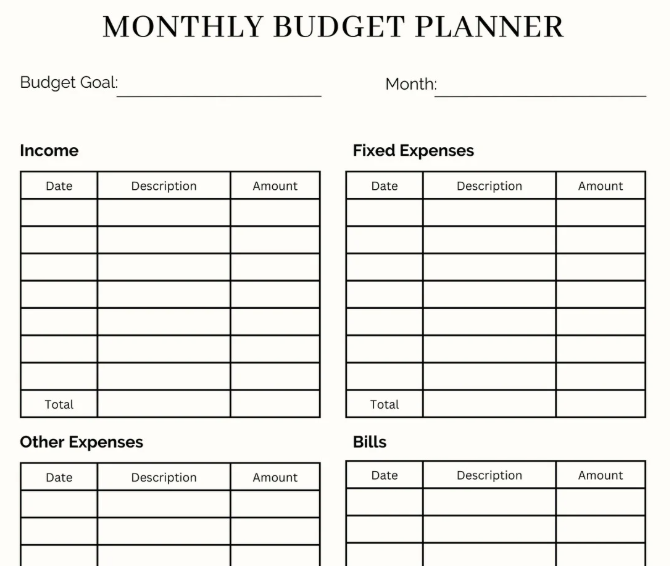
Building your marketing budget means deciding how much you’ll invest in acquiring clients and growing your brand.
Even if your firm is lean on funds, assigning a set monthly amount of $1,000 to start helps you prioritize the most effective channels instead of spreading yourself thin.
Remember: once you learn the skill of marketing you can put a dollar in and earn 3, 5, or 10 dollars back.
But this takes time to learn.
Sometimes to get your marketing profitable a specific marketing channel, you need a minimum monthly spend and depending on the channel, niche, and market you won’t know what that is until you test.
2. Design your law firm website
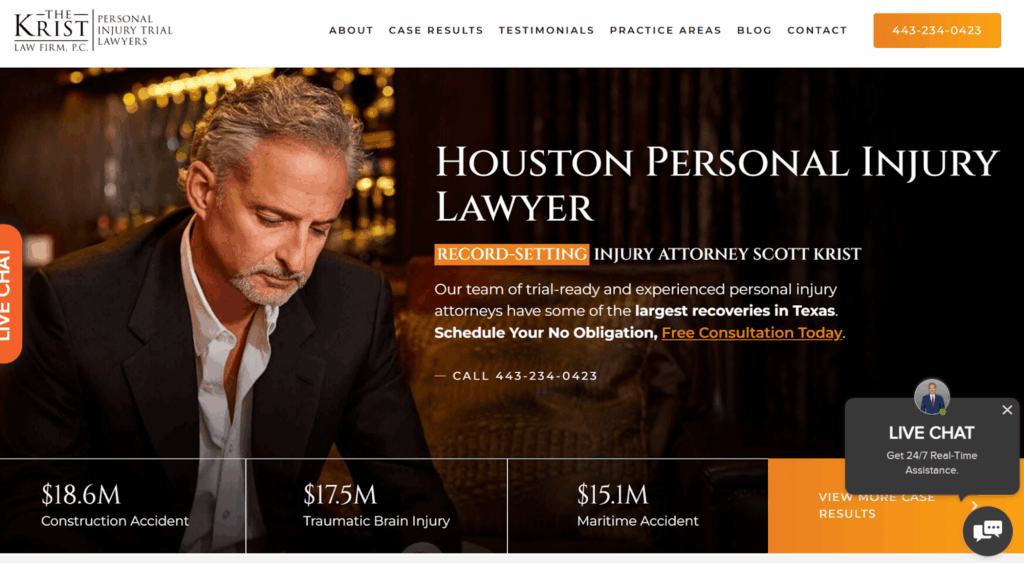
Designing your law firm website means creating a professional, user-friendly space where potential clients can learn about who you are, what you offer, and how to get in touch.
Your website is often your first impression.
It should load quickly, work well on mobile, and include key elements like testimonials, FAQs, and a simple contact form.
If someone lands on your site after Googling “personal injury lawyer near me,” they shouldn’t be confused about what you do or how to reach you.
If you’re just starting out, you can hire someone locally or a freelancer online.
A few simple pages like a homepage, about page, services, and a contact page will be good.
This won’t drive leads for your business by itself but when people see you posting online, they will definitely check out your website before hiring you.
3. Ensure your site is search engine optimized (SEO)
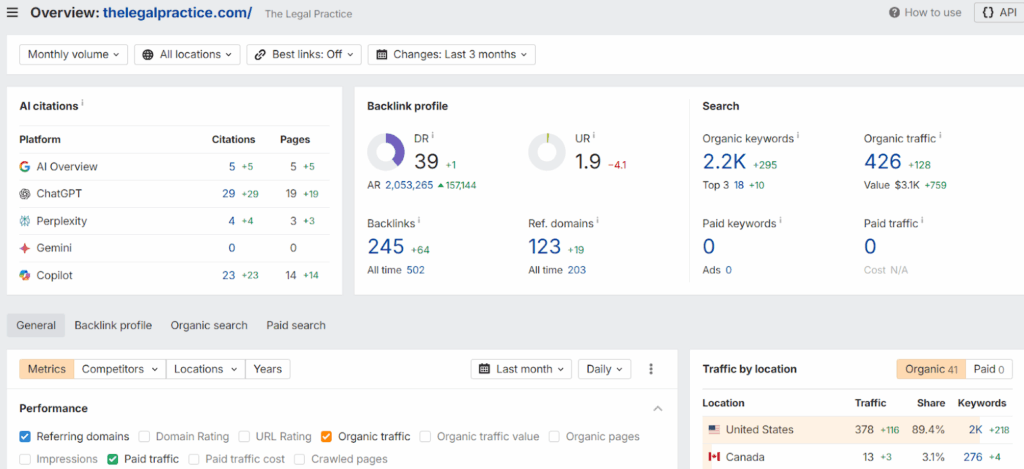
Search engine optimization (SEO) is the practice of improving your site’s visibility in search engines so your ideal clients can find you organically.
It starts with writing helpful content that answers real questions (like “how long after an accident can I file a claim?”), using local keywords, and optimizing your technical backend (site speed, metadata, mobile usability).
For example, a Houston-based firm should rank when someone searches “Houston car accident lawyer”.
SEO makes that happen.
My advice?
SEO is a long term game and is very competitive. If you want leads now, hold off on your SEO strategy until you can invest a significant amount of money into SEO without seeing a return for months.
4. Claim your free online profiles
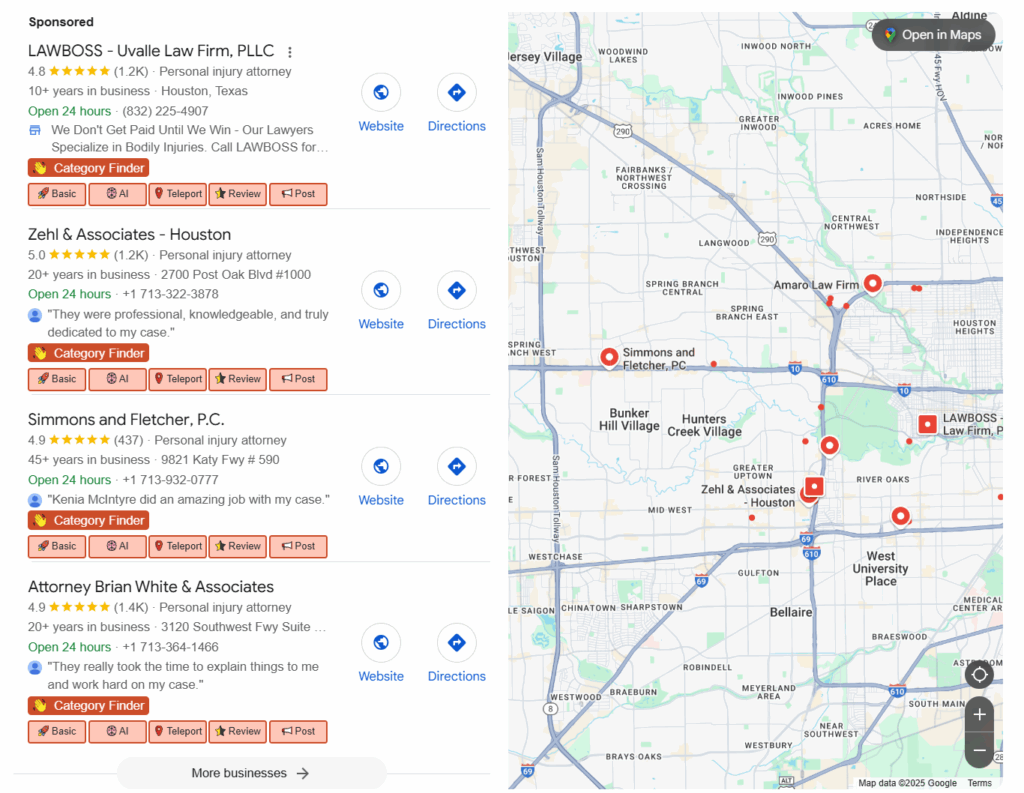
Claiming your free online profiles means taking control of the business listings that already exist for your firm or can be created at no cost.
Start with Google Business Profile, then move to platforms like Yelp, Avvo, and Justia.
These profiles often appear before your website in search results, and they allow you to showcase hours, location, services, and reviews; all of which influence a prospective client’s decision.
There are services on Fiverr that can create hundreds of citations and listings for very little cost.
5. Soliciting online reviews

Reviews are the modern equivalent of word-of-mouth.
They boost trust and also help you rank better in local search results.
A simple way to ask is to send an email saying: “It would mean a lot if you shared your experience on Google; it helps others know they’re in good hands.”
Make sure you provide them a link to the review platform so it’s easy for them.
Pro tip: You’ll likely experience a lot of interactions with an unqualified prospect. But, providing them actionable advice and then following up in an email or text after asking for a review is a very quick way to increase your review count.
6. Use social media
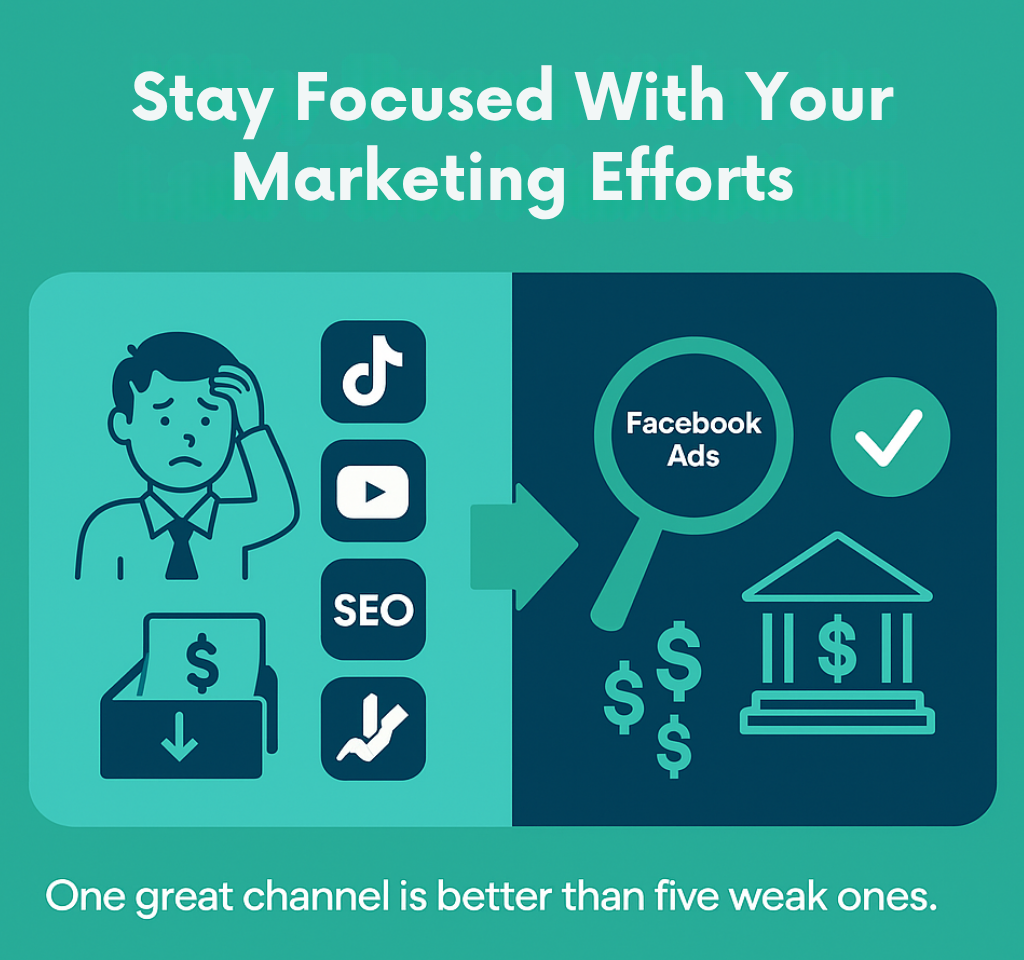
With social media you are building a parasocial relationship with your audience; where you don’t know who they are but they know who you are through your content.
You are building trust and authority with the content you deliver.
This establishes you as the expert in your niche.
You don’t need to be on every platform, pick one or two that fit your audience.
Many personal injury firms do well with Facebook and Instagram for visibility, while B2B-focused firms may find more traction on LinkedIn.
Share behind-the-scenes videos, short legal tips, and client stories to keep your audience engaged.
Pro tip: If you are struggling to find the time to post on social media, pick up your phone and tell a story about an existing client interaction. The questions your current clients ask are often the same questions that your audience has.
7. Do content marketing

Content marketing is creating helpful, valuable content like blog posts, videos, or guides that answer your audience’s questions and build your authority.
For example, a blog post titled “How to Know If You Have a Slip and Fall Case in Texas” can bring in search traffic, educate the reader, and convert them into a lead when paired with a compelling offer (like a free case review).
A good frame of mind to operate from is to pretend that you are talking to a friend that has a problem and you want to provide actionable and useful advice for them.
The keyword is “useful”.
Avoid low-quality AI-generated content. This will only damage your relationship with your audience.
8. Shortform video like TikTok
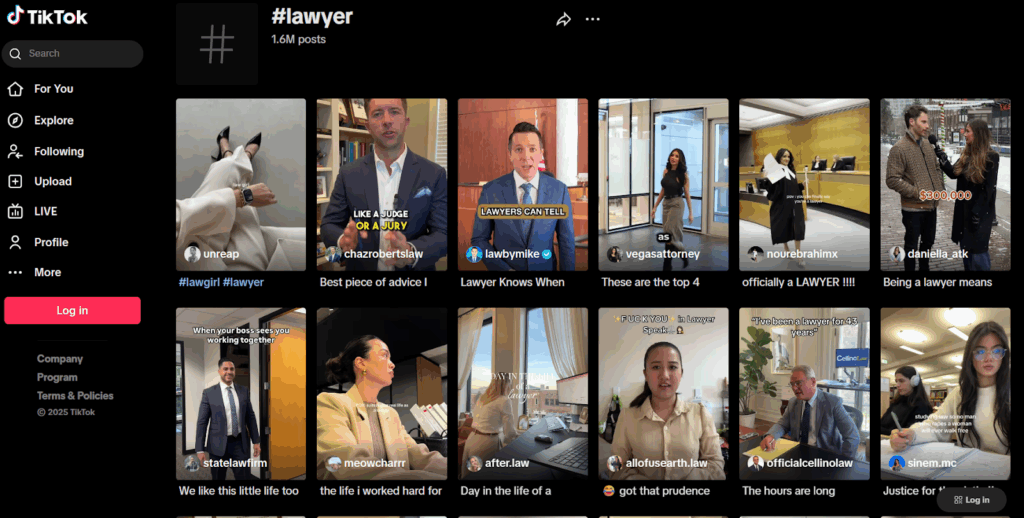
Shortform videos like TikTok give you a fast, casual way to reach new audiences and show your human side.
Think: “3 things you should never say to an insurance adjuster” or “What to do if you’re rear-ended in Texas.”
These videos don’t need to be perfect; just clear, honest, and helpful. Use captions and post consistently.
9. Use lead vendors
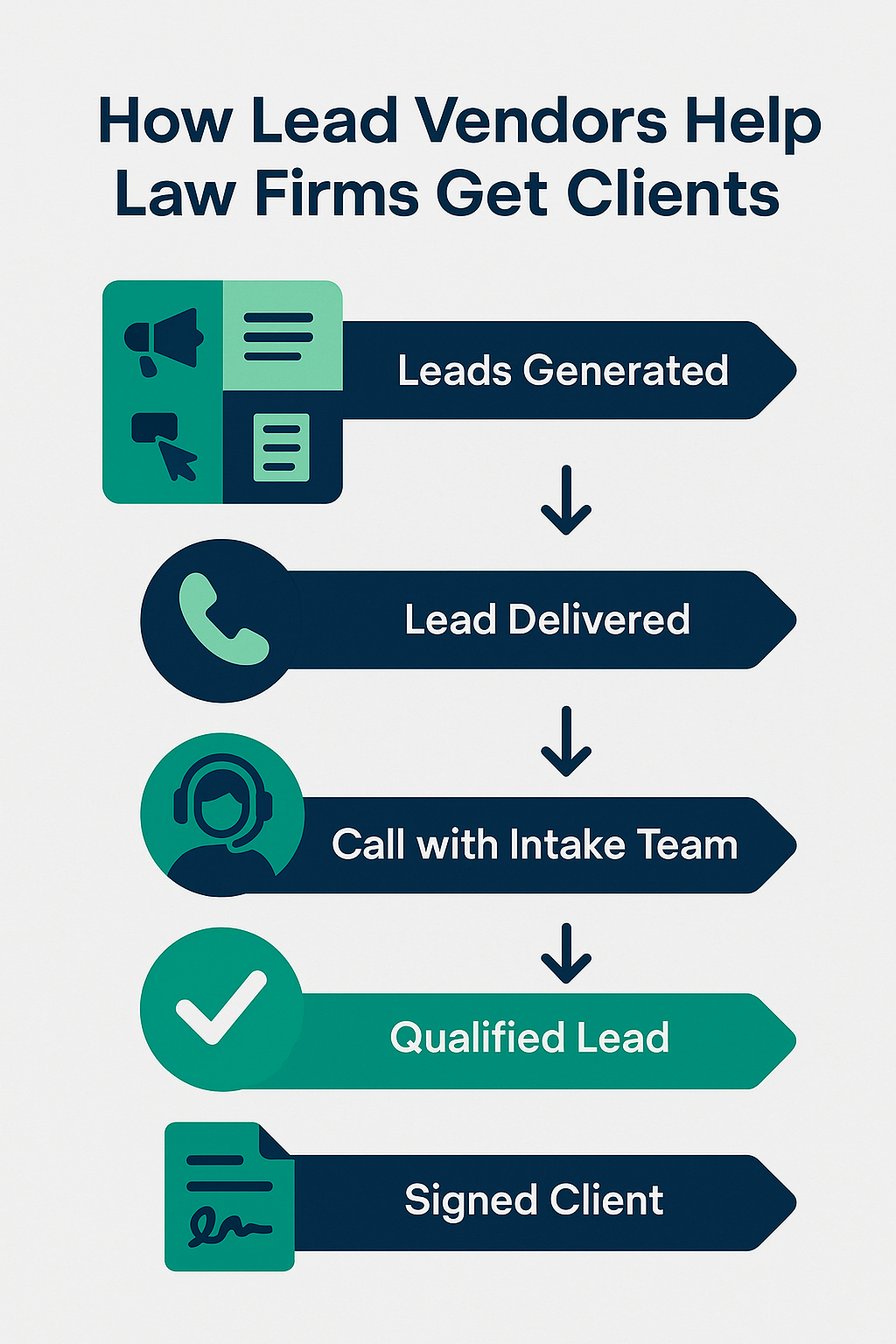
Using lead vendors means paying a third party to send you potential clients who are actively looking for legal help. This can save time on marketing and help you scale quickly if done right.
For example, a personal injury lead vendor might send you phone calls from people who’ve just been in a car accident and haven’t hired a lawyer yet.
For example, you might pay $150 per lead and track results from there.
Lead vendors can be a great way to test offers and boost volume, but you have to watch your numbers.
If you’re paying $150 per lead, converting 1 in 5 to a call ($750/call), and closing 1 in 2 into a client ($1,500 CPA), then the system works.
Just don’t treat vendors as a silver bullet, use them alongside your own marketing for the best long-term results.
10. Networking and business development
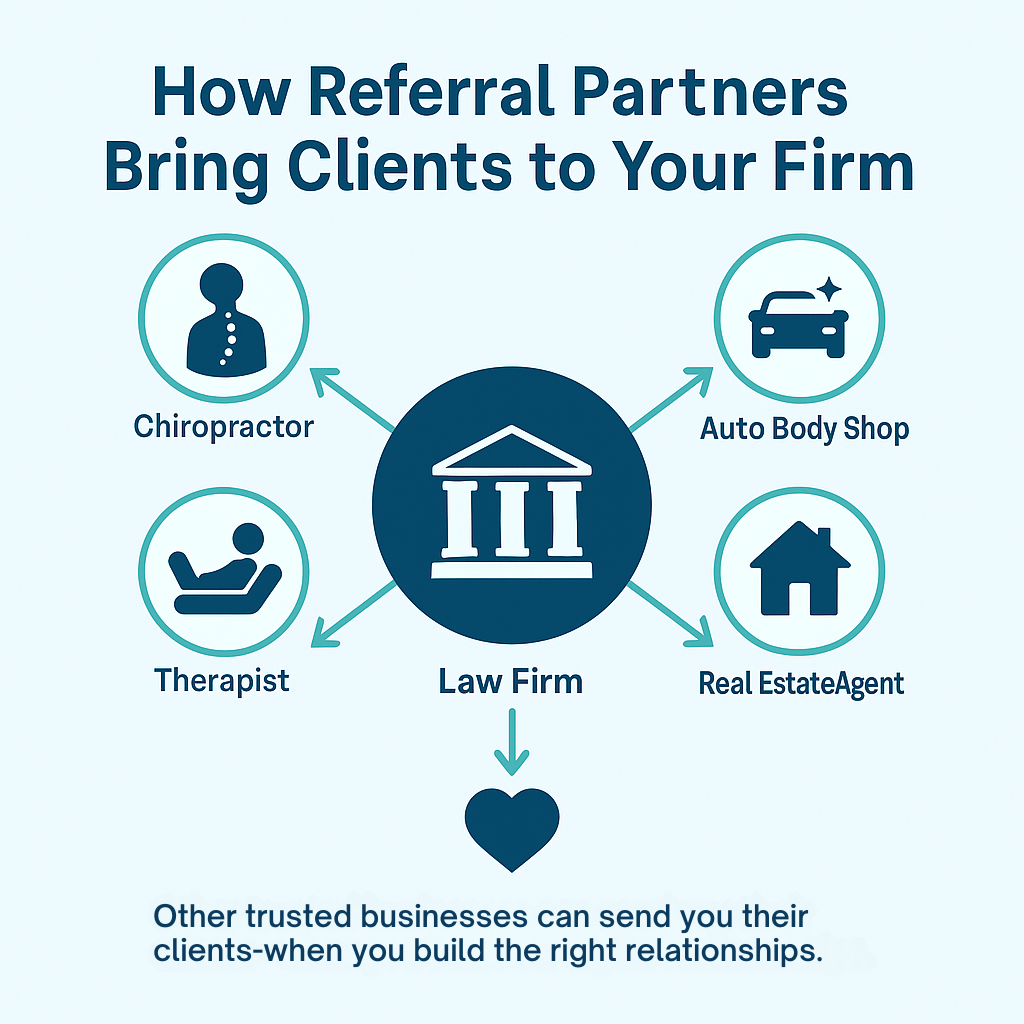
Networking and business development refers to the human side of marketing; building relationships with referral partners, community groups, and other professionals.
Attend events, speak at local panels, or join business associations.
If you’re a family lawyer, for instance, building relationships with therapists, counselors, and financial advisors can create a strong referral loop.
Pro tip: Think about where your audience is and who they also buy from. For example, a cross-border business lawyer can develop relationships with financial planners for high net worth individuals. The financial planner’s clients often own businesses and some may need a tax lawyer. With proper networking you can create a reliable stream of referrals.
11. Measure marketing KPIs
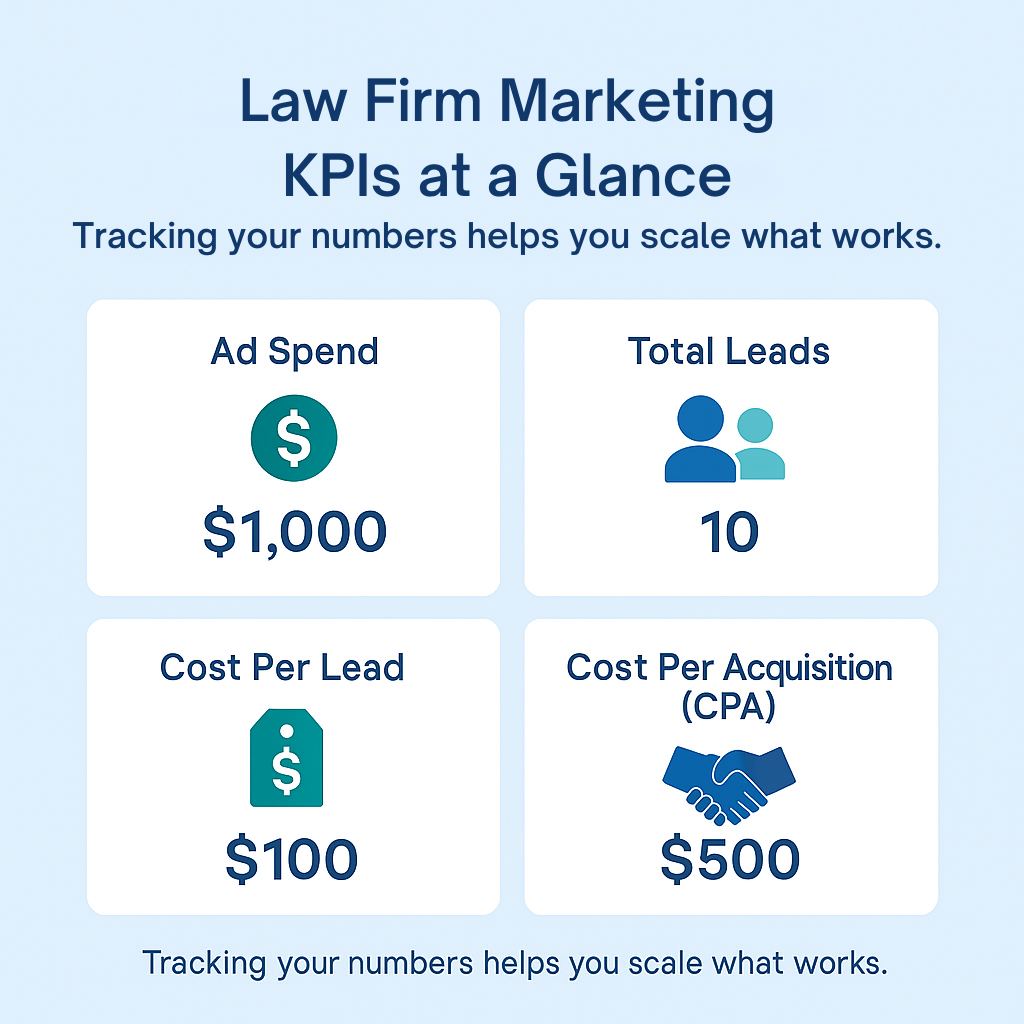
Measuring marketing KPIs means tracking key performance indicators that show whether your efforts are actually working.
Don’t overcomplicate it; start with a few: how many leads you got, how much you spent, and how many clients signed.
If you spent $1,000 and got 10 qualified leads, your cost per lead is $100. Track that monthly to understand what’s driving results.
12. Evaluate and adjust
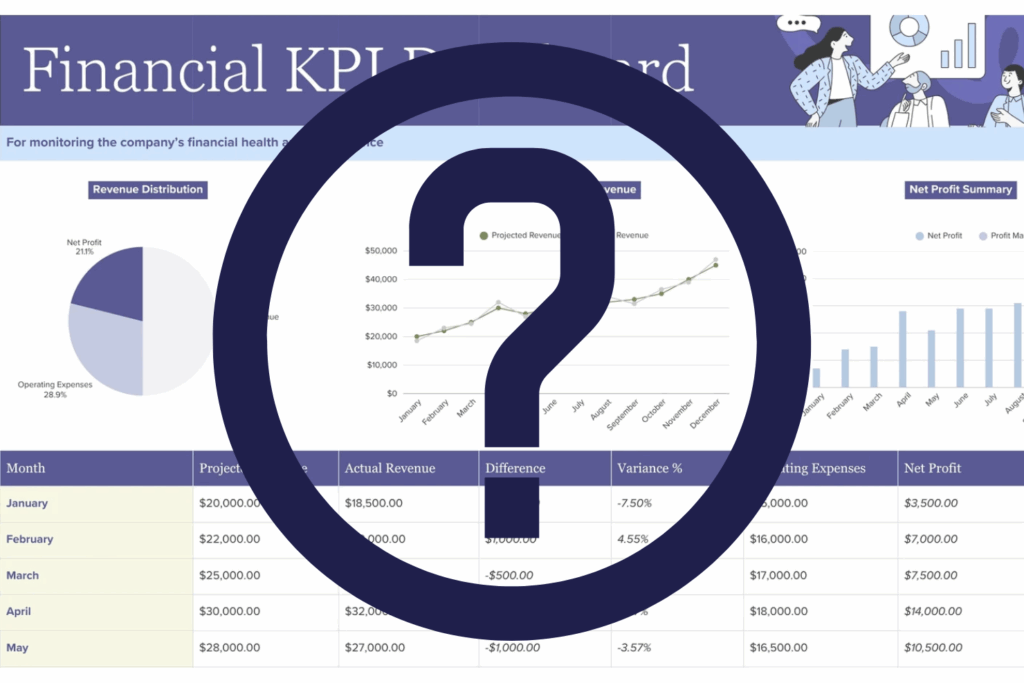
Evaluating and adjusting is what turns marketing from a guessing game into a real growth engine.
Look at your numbers every month. Did that blog post drive traffic? Did your TikTok bring in any calls?
If something isn’t working, tweak the offer, change the format, or reallocate budget.
It’s easy to feel like your marketing ‘isn’t working’ at first. But the firms that win are the ones who treat it like a process, not a one-shot campaign
Law Firm Marketing Examples
It’s easy to talk about marketing in broad strokes, but the real proof is in what actually works.
Here are three real-world examples of lawyers using different strategies; SEO, lead generation, and content to grow their practices and reach more of the right clients.
This is exactly what I’ve seen work with real firms—on the ground, not just in strategy decks
1. Personal Injury SEO: From Low Clicks to Consistent Leads
This client of ours started with around 35 organic clicks a day; decent, but not enough to generate consistent growth. I developed an SEO plan targeting high-intent legal topics, especially local queries around personal injury.
Multiple blog posts now rank on the first page for high-intent keywords, and their local map listing holds strong top positions in their city.
One standout is a winter slip-and-fall article that brings in dozens of leads per week during colder months, but it's part of a larger SEO strategy that's now delivering results daily.
Today, their site brings in 90 clicks per day; nearly triple what they started with, and their leads from SEO have doubled overall.
No ad spend. Just targeted, compounding organic traffic that keeps delivering.
Here’s a look at the client’s Google Search Console performance.
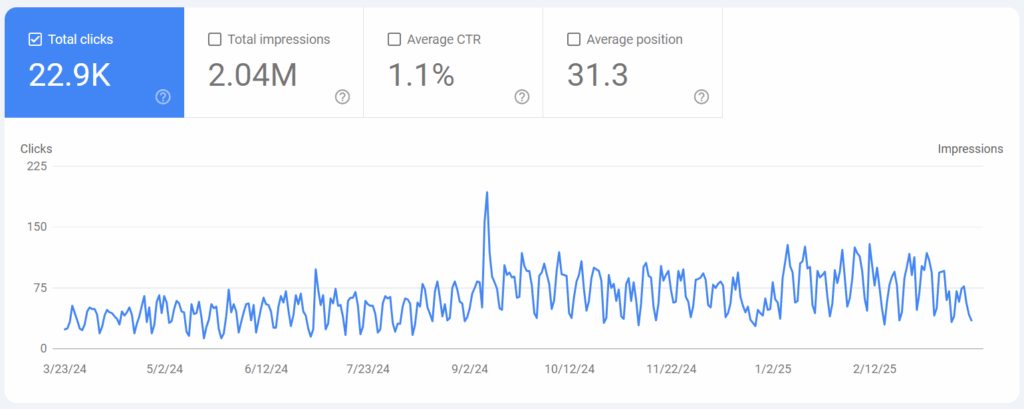
2. Personal Injury Lead Vendor: High-Intent, Live-Transfer Calls
For another client, I used a direct response approach with live call transfers. These are warm leads; people who’ve already clicked an ad, answered screening questions, and are now on the phone ready to talk to a lawyer.
In total, we’ve sent 83 live calls, and 9 converted into signed clients. That’s a conversion rate of just under 11%, which is strong for personal injury.
The important thing here is the client’s cost-per-acquisition (CPA) is well under their target.
At volume, this kind of system delivers predictable, scalable growth as long as intake is sharp and follow-up is fast.
Here’s a sample of the client’s disposition report.
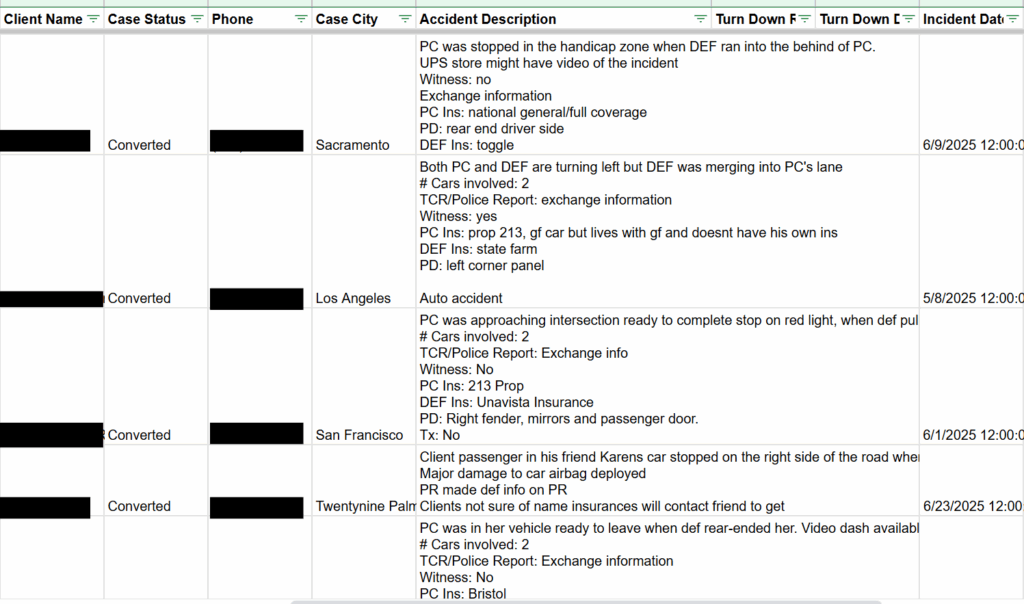
3. Mike Rafi: Mastering Content Marketing at Scale
Mike Rafi isn’t our client, but he’s a textbook example of how content marketing can build authority and trust at scale.
His YouTube channel racks up millions of views per week, and he regularly posts shortform videos where he breaks down legal scenarios, explains client rights, and shares tips most people don’t know they need.
The genius behind his strategy is consistency and clarity; he talks like a real person, not like a lawyer reading a statute. That’s why his content spreads so easily.
Even without pitching his firm in every video, Mike positions himself as the go-to authority on personal injury law in his region. When someone eventually needs a lawyer, they already trust him; and that’s the long game of marketing done right.
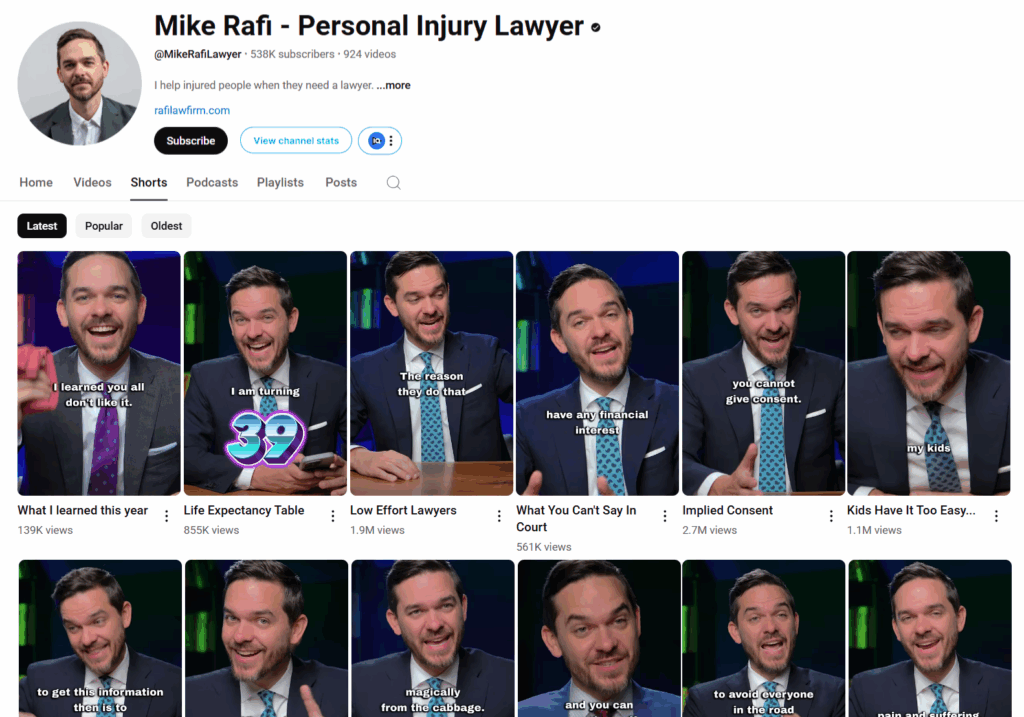
How To Get Started With Law Firm Marketing in 5 Steps
Ready to start marketing your law firm or legal services? Start with these
Step 1: Choose Your Channel(s)
If you’re just getting started with marketing your law firm, the biggest mistake you can make is trying to do everything at once. Don’t. The fastest path to results is choosing one marketing channel and going all-in on it.
Whether it’s content, Facebook ads, TikTok, SEO, or building referral partnerships; pick the one channel that fits your practice and your personality, and put 100% of your effort into mastering it.
When you go deep instead of wide, your learnings compound, your results scale faster, and you avoid burning out from trying to juggle ten things at once.
How do you pick the right channel?
That depends on your niche, your location, and the offer you're leading with.
For example, if you're a personal injury lawyer, SEO might be your long game, but TikTok or Facebook ads could generate calls fast. If you're a business lawyer in a small city, referral partners might be your most valuable asset.
To figure out where to focus, do your homework:
- Ask other lawyers or legal marketers what’s worked for them.
- Join legal marketing communities or coaching programs to see what others are running.
- Browse Reddit threads where professionals share strategies specific to your practice area.
- Talk to other local businesses that share your audience—even if they're not in law.
Once you find a channel that seems like it could work in your space, commit. Test, refine, learn—and only think about expanding once you’ve built a system that’s producing real, measurable results.
The bottom line? Focus beats variety. Especially in the beginning.
Step 2: Match Your Strategy to Your Resources
The right channel for you isn’t only about your niche; it’s also about what you have more of: money or time. Some strategies require a bigger budget but less time. Others are time-intensive but cost very little.
Here’s a quick cheat sheet to help you decide where to start based on your situation:
| Time Available | Budget Available | Best Strategy to Start With |
|---|---|---|
| Low | High | Paid ads (Google, Facebook, TikTok) |
| High | Low | Content marketing, SEO, organic social |
| Low | Low | Direct outreach, referral partnerships, community networking |
| High | High | Multi-channel: ads + content + SEO + outreach (scale faster) |
If you’ve got more time than money, invest it into things like blogging, videos, or building relationships with people who can refer clients your way.
If you’ve got money but no time, ads can work—just make sure you’ve got solid intake systems in place.
And if you're short on both, focus on personal outreach. It's not scalable, but it's still effective when you're starting from zero.
The key is to be honest about your bandwidth, and then fully commit to the path that fits your current reality.
Step 3: Learn Law Firm Marketing Concepts
Offer
Your offer is what you present to get someone to raise their hand and say "I'm interested." For law firms, this isn’t always a “discount” like in e-commerce — it’s often a free value exchange.
Examples of good legal offers:
- Free consultation or case review
- Free downloadable guide (e.g., “What To Do Right After a Car Accident”)
- “No win, no fee” promise (common in personal injury)
Brand
Your brand is how people think and feel about you when they see your name. It’s your reputation, your promise, and your personality all rolled into one.
For law firms, this means being known as the “trusted local expert” or “the lawyer who fights for the little guy.” Visual consistency, clear messaging, and authentic stories build brand memory.
Traffic
Traffic means getting eyeballs on your offer; views, clicks, impressions, visitors. You can’t convert what you don’t attract.
In law firm marketing, traffic might come from SEO (people searching for “Houston personal injury lawyer”), Google Ads, social media posts, or referral partnerships.
Conversion Mechanisms and Landing Pages
Once you have traffic, you need to convert it into leads. This is where landing pages, lead forms, and “conversion mechanisms” come in.
Examples:
- A quiz form ("Find Out If You Have a Case in 60 Seconds")
- A video sales letter, case study or testimonial page
- A lead magnet download page (guide or checklist)
Cost per lead (CPL)
CPL measures how much you pay to generate a single qualified lead (someone who gives you their info). It’s a critical KPI to track if your funnel is working efficiently.
Cost per call/meeting
Cost per call or meeting looks at what it costs to get an actual conversation booked. This is usually higher than CPL because not every lead will book a call.
Cost per acquisition (CPA)
CPA tells you what it actually costs to secure a new client who signs a retainer or agreement. This is the ultimate metric for judging profitability. If you can get this number low enough to where it’s actually scalable then you simply just need to put more dollars into the channel.
Step 4: Choose Law Firm Marketing Tools
Law firm marketing tools take many shapes and forms, from digital marketing software, to paid ad management, or even SEO or outsourced help. Here are some platforms you can try:
Find more law firm marketing tools here:
Step 5: Keep Learning About Legal Marketing
You can learn more about this topic here:
- Legal marketing podcasts for your morning commute
- Legal marketing books or law firm marketing books for your weekend read
Join For More Law Firm Marketing Insights
For more legal insights and resources, subscribe to The Legal Practice newsletter and join a community of innovative legal practitioners shaping the future of law.
